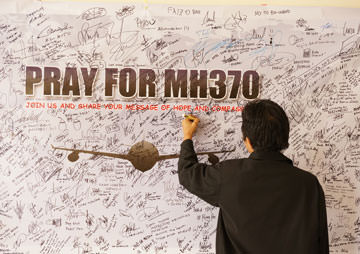Malaysia Airlines: Into the Twilight Zone
Let me go out on a limb: The Malaysian airliner did not get sucked into a black hole, vanish over the Indian Ocean equivalent of the Bermuda Triangle or crash-land on the spooky island from "Lost." Shahrul Azman / Shutterstock.com
Shahrul Azman / Shutterstock.com
Let me go out on a limb: The Malaysian airliner did not get sucked into a black hole, vanish over the Indian Ocean equivalent of the Bermuda Triangle or crash-land on the spooky island from “Lost.”
Those “theories” were actually discussed on CNN this week. Host Don Lemon dismissed them as “preposterous” before asking one of his assembled “expert” guests — there were six of them waiting expectantly in their boxes on the screen — whether, you know, such ideas really were so preposterous.
At which point the nonstop coverage of this tragedy entered the Twilight Zone.
The disappearance of Malaysia Airlines Flight 370 is pretty close to a pure mystery. The news media — especially the cable television networks — have responded with an orgy of what can only be called pure speculation. Far too often, as every journalist knows, the facts get in the way of a good story. In this case, there aren’t any indisputably consequent facts except one: On March 8, a jetliner with 239 people aboard went missing.
On second thought, I guess there’s one other fact that matters: The mystery is so compelling that people can’t seem to get enough of it. CNN has soared to the top of the cable news ratings — at times besting even behemoth Fox News — by covering the story ceaselessly, and by that I mean you wonder when the anchors get a chance to go to the bathroom.
Late Wednesday night, when Australian officials announced that a satellite had spotted what might be two pieces of floating debris in a remote part of the ocean, Anderson Cooper announced via Twitter that he was rushing back to the studio to cover this breaking development. Lemon was already on the air and had reported several times the entirety of what the Australians said — two pieces of debris, maybe, which might or might not be from the plane — but Cooper soon arrived to tell us the same thing, as if we were hard of hearing.
I guess I shouldn’t complain, though, because at least that speculation was about the possible sighting of possible wreckage. Much of the coverage over the past week, absent even the hint of a glimpse of physical evidence, has attempted to sketch psychological profiles of the pilot and co-pilot in an attempt to ascertain, or guess, whether the plane could have been deliberately crashed.
It was deemed significant, for a day or so, that it was the co-pilot who last spoke to air traffic controllers, not the pilot. Then Malaysian authorities announced that the pilot had erased some data from the flight simulator he kept at home. No one yet knows what kind of data that was, or whether it had any bearing on what happened to flight 370, but it did seem to make everyone forget about the co-pilot.
Speaking of the Malaysian authorities, they have poured buckets of gasoline onto this bonfire of speculation. They have given so many different versions of basic facts — when was the plane last heard from, which way it was heading — that “according to Malaysian officials” has become shorthand for “don’t take this too seriously.”
In the absence of solid information, air time has been filled with guesswork. The best is educated guessing — for example, the clever satellite triangulation that indicates searchers should concentrate on a wide arc stretching north into central Asia and south into tracts of the Indian Ocean far from shipping lanes. The possible debris spotted by the Australians is near that arc.
Another educated guess is that a fire could have broken out in the cockpit and the pilots, before being overcome by smoke, could have switched off some electric circuits to find out what was burning while also turning the plane to head for the nearest airport. This scenario has been challenged, however, by those who say it doesn’t account for all the zigzags the plane seems to have made before disappearing from radar.
See? I’m doing it too — writing confidently about what might have happened without the burdensome constraint of relevant factual information.
I think there must be something in all of us that is drawn to mysteries and disappearances. When stories are incomplete, we have an instinct to write endings. “What happened?” is the basic question that all journalism tries to answer.
But when we don’t know the answer, we should just say so — then shut up. Endless content-free coverage deserves to be eaten by a black hole.
Eugene Robinson’s e-mail address is eugenerobinson(at)washpost.com.
© 2014, Washington Post Writers Group
Your support matters…
Independent journalism is under threat and overshadowed by heavily funded mainstream media.
You can help level the playing field. Become a member.
Your tax-deductible contribution keeps us digging beneath the headlines to give you thought-provoking, investigative reporting and analysis that unearths what's really happening- without compromise.
Give today to support our courageous, independent journalists.








You need to be a supporter to comment.
There are currently no responses to this article.
Be the first to respond.